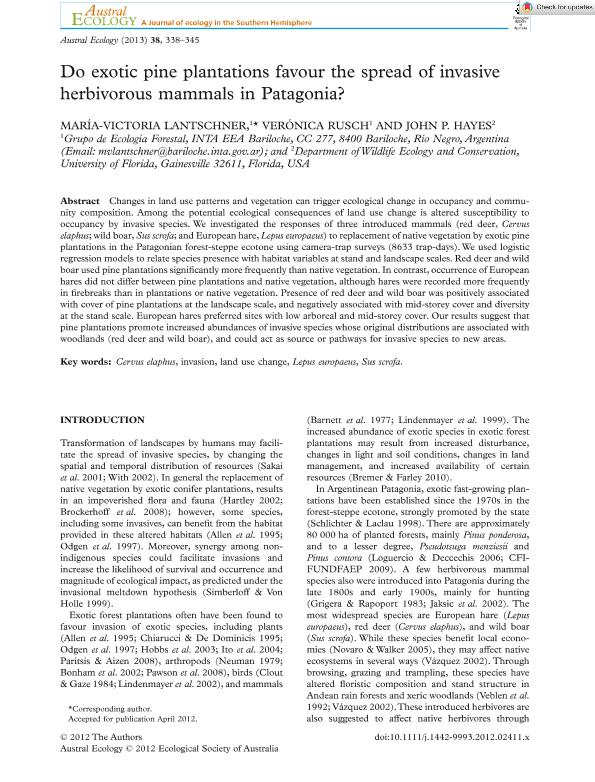Mostrar el registro sencillo del ítem
dc.contributor.author
Lantschner, María Victoria

dc.contributor.author
Rusch, Verónica
dc.contributor.author
Hayes, John P.
dc.date.available
2017-06-06T21:04:18Z
dc.date.issued
2013-05
dc.identifier.citation
Lantschner, María Victoria; Rusch, Verónica; Hayes, John P.; Do exotic pine plantations favour the spread of invasive herbivorous mammals in Patagonia?; Wiley; Austral Ecology; 38; 3; 5-2013; 338-345
dc.identifier.issn
1442-9985
dc.identifier.uri
http://hdl.handle.net/11336/17634
dc.description.abstract
Changes in land use patterns and vegetation can trigger ecological change in occupancy and community composition. Among the potential ecological consequences of land use change is altered susceptibility to occupancy by invasive species. We investigated the responses of three introduced mammals (red deer, Cervus elaphus; wild boar, Sus scrofa; and European hare, Lepus europaeus) to replacement of native vegetation by exotic pine plantations in the Patagonian forest-steppe ecotone using camera-trap surveys (8633 trap-days). We used logistic regression models to relate species presence with habitat variables at stand and landscape scales. Red deer and wild boar used pine plantations significantly more frequently than native vegetation. In contrast, occurrence of European hares did not differ between pine plantations and native vegetation, although hares were recorded more frequently in firebreaks than in plantations or native vegetation. Presence of red deer and wild boar was positively associated with cover of pine plantations at the landscape scale, and negatively associated with mid-storey cover and diversity at the stand scale. European hares preferred sites with low arboreal and mid-storey cover. Our results suggest that pine plantations promote increased abundances of invasive species whose original distributions are associated with woodlands (red deer and wild boar), and could act as source or pathways for invasive species to new areas.
dc.format
application/pdf
dc.language.iso
eng
dc.publisher
Wiley

dc.rights
info:eu-repo/semantics/openAccess
dc.rights.uri
https://creativecommons.org/licenses/by-nc-sa/2.5/ar/
dc.subject
Cervus Elaphus
dc.subject
Sus Scrofa
dc.subject
Lepus Europaeus
dc.subject
Land Use Change
dc.subject
Invasion
dc.subject.classification
Ecología

dc.subject.classification
Ciencias Biológicas

dc.subject.classification
CIENCIAS NATURALES Y EXACTAS

dc.title
Do exotic pine plantations favour the spread of invasive herbivorous mammals in Patagonia?
dc.type
info:eu-repo/semantics/article
dc.type
info:ar-repo/semantics/artículo
dc.type
info:eu-repo/semantics/publishedVersion
dc.date.updated
2015-10-15T20:00:30Z
dc.journal.volume
38
dc.journal.number
3
dc.journal.pagination
338-345
dc.journal.pais
Estados Unidos

dc.journal.ciudad
Hoboken
dc.description.fil
Fil: Lantschner, María Victoria. Instituto Nacional de Tecnología Agropecuaria. Centro Regional Patagonia Norte. Estación Experimental Agropecuaria San Carlos de Bariloche; Argentina. Consejo Nacional de Investigaciones Científicas y Técnicas; Argentina
dc.description.fil
Fil: Rusch, Verónica. Instituto Nacional de Tecnología Agropecuaria. Centro Regional Patagonia Norte. Estación Experimental Agropecuaria San Carlos de Bariloche; Argentina
dc.description.fil
Fil: Hayes, John P.. University Of Florida; Estados Unidos
dc.journal.title
Austral Ecology

dc.relation.alternativeid
info:eu-repo/semantics/altIdentifier/doi/http://dx.doi.org/10.1111/j.1442-9993.2012.02411.x
dc.relation.alternativeid
info:eu-repo/semantics/altIdentifier/url/http://onlinelibrary.wiley.com/doi/10.1111/j.1442-9993.2012.02411.x/abstract
Archivos asociados
